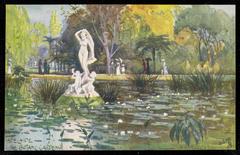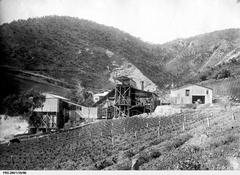Comprehensive Guide to Visiting Adelaide Himeji Garden, Adelaide, Australia
Date: 23/07/2024
Introduction
Nestled within the lush Adelaide Park Lands, the Adelaide Himeji Garden stands as a serene emblem of international friendship and cultural exchange. Established in 1985, this tranquil oasis symbolizes the sister city relationship between Adelaide, Australia, and Himeji, Japan, a bond formalized in 1982 (Adelaide City Council). Designed by Japanese landscape architect Yoshitaka Kumada, the garden beautifully merges traditional Japanese aesthetics with natural elements, creating a harmonious space that fosters reflection and peace (Japan National Tourism Organization). Visitors to the garden can explore two classic Japanese garden styles: the senzui, or lake and mountain garden, and the kare-sansui, or dry rock garden. Each section is meticulously crafted to evoke the essence of Japanese landscapes and philosophical principles.
The Adelaide Himeji Garden is more than a picturesque retreat; it is a cultural bridge that promotes mutual understanding and appreciation between Australia and Japan. This garden hosts various cultural events, such as tea ceremonies and ikebana workshops, allowing visitors to immerse themselves in traditional Japanese practices (Adelaide Himeji Garden Events). The garden’s establishment coincided with a period of heightened interest in Japanese culture in Australia during the 1980s, reflecting a broader trend of globalization and cultural exchange (History.com). Today, the Adelaide Himeji Garden continues to be a vital part of Adelaide’s cultural and historical landscape, offering a peaceful sanctuary for visitors and a testament to the enduring friendship between the two cities.
Table of Contents
- Origins and Establishment
- Design and Layout
- Cultural Significance
- Symbolism and Elements
- Historical Context
- Contributions to Adelaide’s Heritage
- Visitor Experience
- Nearby Attractions
- Preservation and Maintenance
- Educational and Cultural Programs
Origins and Establishment
The Adelaide Himeji Garden, located in the southern parklands of Adelaide, South Australia, is a symbol of the sister city relationship between Adelaide and Himeji, Japan. This relationship was formalized in 1982, and the garden was officially opened in 1985. The garden was designed by Japanese landscape designer Yoshitaka Kumada, who aimed to create a space that embodies the essence of Japanese aesthetics and philosophy (Adelaide City Council).
Design and Layout
The garden is a blend of two classic Japanese garden styles - the senzui (lake and mountain garden) and the kare-sansui (dry rock garden). The senzui style features a serene pond, a waterfall, and a variety of plant species that are native to Japan, while the kare-sansui style uses rocks and sand to represent water and mountains, creating a tranquil and contemplative space (Japan National Tourism Organization).
Cultural Significance
The Adelaide Himeji Garden serves as a cultural bridge between Australia and Japan, promoting mutual understanding and appreciation of each other’s traditions and values. The garden is not just a place of beauty but also a space for cultural exchange, hosting various events such as tea ceremonies, ikebana (flower arranging) workshops, and traditional Japanese festivals (Adelaide Himeji Garden Events).
Symbolism and Elements
The Pond and Waterfall
The pond and waterfall in the senzui section symbolize the natural landscapes of Japan. The pond is home to koi fish, which are considered symbols of perseverance and strength in Japanese culture. The waterfall represents the continuous flow of life and the passage of time, encouraging visitors to reflect on their own journeys (Koi Fish Symbolism).
The Dry Rock Garden
The kare-sansui section, or dry rock garden, is designed to evoke a sense of peace and contemplation. The carefully raked gravel represents water, while the strategically placed rocks symbolize islands or mountains. This section of the garden encourages mindfulness and meditation, offering a space for visitors to find inner peace (Dry Rock Garden Philosophy).
Historical Context
The establishment of the Adelaide Himeji Garden in the mid-1980s coincided with a period of growing interest in Japanese culture and aesthetics in Australia. This was part of a broader trend of cultural exchange and globalization that characterized the late 20th century. The garden was one of several initiatives aimed at fostering international relationships and cultural understanding during this time (History.com).
Contributions to Adelaide’s Heritage
The Adelaide Himeji Garden is an integral part of Adelaide’s cultural and historical landscape. It contributes to the city’s heritage by preserving and showcasing traditional Japanese gardening techniques and philosophies. The garden is also a testament to the enduring friendship between Adelaide and Himeji, symbolizing the importance of international cooperation and cultural diplomacy (Adelaide’s Cultural Heritage).
Visitor Experience
Visiting Hours and Tickets
The Adelaide Himeji Garden is open daily from 8 am to 5:30 pm. Admission is free, making it an accessible attraction for everyone. However, donations are welcome to assist with the garden’s maintenance and preservation (Adelaide Himeji Garden Tickets).
Guided Tours and Events
Guided tours are available for groups and can be booked in advance. These tours provide a deeper understanding of the garden’s elements and their cultural significance. The garden also hosts various events throughout the year, such as tea ceremonies and flower arranging workshops (Adelaide Himeji Garden Events).
Nearby Attractions
While visiting the Adelaide Himeji Garden, consider exploring other nearby attractions in Adelaide. The Adelaide Botanic Garden, Art Gallery of South Australia, and the South Australian Museum are all within a short distance and offer additional cultural and historical experiences (Adelaide Historical Sites).
Preservation and Maintenance
Maintaining the Adelaide Himeji Garden requires a deep understanding of traditional Japanese gardening techniques and a commitment to preserving its authenticity. The garden is meticulously cared for by a team of skilled gardeners who ensure that every element remains true to its original design. This dedication to preservation ensures that the garden continues to be a place of beauty and cultural significance for future generations (Garden Maintenance Practices).
Educational and Cultural Programs
The Adelaide Himeji Garden also serves as an educational resource, offering programs and workshops that teach visitors about Japanese culture and gardening techniques. These programs are designed to foster a deeper understanding and appreciation of Japanese traditions, promoting cultural exchange and learning. Schools and community groups often visit the garden as part of their educational curricula, making it a valuable resource for cultural education (Educational Programs).
Conclusion
The Adelaide Himeji Garden is more than just a beautiful space; it is a living symbol of the friendship between Adelaide and Himeji, a testament to the power of cultural exchange, and a place of peace and reflection. Its history and significance are deeply intertwined with the broader narrative of globalization and cultural diplomacy, making it a vital part of Adelaide’s heritage and a must-visit destination for anyone interested in Japanese culture and aesthetics.
FAQ
What are the visiting hours for Adelaide Himeji Garden? The garden is open daily from 8 am to 5:30 pm.
How much are tickets for Adelaide Himeji Garden? Admission is free, but donations are welcome.
Are there guided tours available? Yes, guided tours can be booked in advance.
What events are held at the garden? The garden hosts various events such as tea ceremonies, ikebana workshops, and traditional Japanese festivals.
Are there nearby attractions? Yes, nearby attractions include the Adelaide Botanic Garden, Art Gallery of South Australia, and the South Australian Museum.
References
- Adelaide Himeji Garden - Visiting Hours, Tickets, and Cultural Significance. (2024). Adelaide City Council
- Complete Guide to Visiting Adelaide Himeji Garden - Hours, Tickets, and Tips. (2024). Japan National Tourism Organization
- Explore the Adelaide Himeji Garden - Visiting Hours, Tickets, and Highlights. (2024). Adelaide Himeji Garden Events
- Globalization and Cultural Exchange. (2024). History.com
- Adelaide’s Cultural Heritage. (2024). Adelaide City Council
- Educational Programs. (2024). Adelaide Himeji Garden Educational Programs











